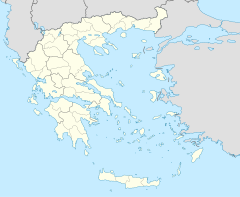
In Eastern Christianity, an iconostasis is a wall of icons and religious paintings, separating the nave from the sanctuary in a church. Iconostasis also refers to a portable icon stand that can be placed anywhere within a church. The iconostasis evolved from the Byzantine templon, a process complete by the 15th century.

Elena is a Bulgarian town in the central Stara Planina mountain in Veliko Tarnovo Province, located 42 km southeast of Veliko Tarnovo. It is the administrative centre of the homonymous Elena Municipality. The area is also a mountain resort, known for the typical local cuisine. As of December 2009, the town has a population of 5,665 inhabitants. It forms a terminal for the Gorna Oryahovitsa-Elena railway line.

The Bachkovo Monastery of the Dormition of the Theotokos, archaically the Petritsoni Monastery or Monastery of the Mother of God Petritzonitissa is a major Eastern Orthodox monastery in Southern Bulgaria. It is located on the right bank of the Chepelare River, 189 km from Sofia and 10 km south of Asenovgrad, and is directly subordinate to the Holy Synod of the Bulgarian Orthodox Church. The monastery is known and appreciated for the unique combination of Byzantine, Georgian and Bulgarian culture, united by the common faith.

Our Mother of Perpetual Succour is a Roman Catholic title of the Blessed Virgin Mary associated with a fifteenth—century Byzantine icon and a reputed Marian apparition. The image has been enshrined in the Church of San Matteo in Via Merulana since 27 March 1499, and is today permanently enshrined in the Church of Saint Alphonse of Liguori, where the official Novena to Our Mother of Perpetual Help text is prayed weekly.

The Cathedral of St. Sophia, the Holy Wisdom of God in Veliky Novgorod, Russia, is the cathedral church of the Metropolitan of Novgorod and the mother church of the Novgorodian Eparchy.
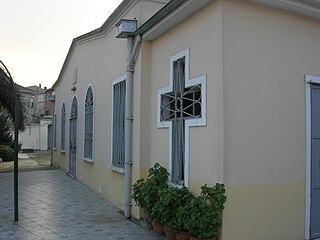
The Church of Saint Mary of Blachernae is an Eastern Orthodox church in Mustafa Paşa Bostanı Sokak in Ayvansaray in the Fatih district of Istanbul, just inside the old walled city. During the latter part of the Byzantine period and until its destruction in 1434 it was one of the most important sanctuaries of Byzantium, arguably outstripping Hagia Sophia in importance due to its proximity to the Palace of the Blachernae. Today it is protected by a high wall, and fronted by a garden.

The Cathedral of Hajdúdorog, officially Greek Catholic Cathedral of the Presentation of Mary in Hajdúdorog is the cathedral of the Archeparchy of Hajdúdorog, Hungary. This status ranks the cathedral among the most important buildings of the Hungarian Greek Catholic Church. The origins of the current cathedral reaches back to 1312, when historical notes mention that a church existed in the medieval settlement of Dorogegyháza. However, the present building has 17th century foundations, and it went through several building extensions and renovations during its history. The latest restoration were completed in 2006.

The iconostasis of the Cathedral of Hajdúdorog is the largest Greek Catholic icon screen in Hungary. It is 11 m tall and 7 m wide, holding 54 icons on five tiers. Creating such a monumental work of art requires a number of different craftsmen. Miklós Jankovits was hired by the Greek Catholic parish of Hajdúdorog in 1799 to carve the wooden framework, including the doors and the icon frames of the iconostasis. Mátyás Hittner and János Szűts could only start the painting and gilding works in 1808. The last icon was completed in 1816.

The Metropolitan Cathedral of the Holy and Equal-to-the-Apostles Mary Magdalene is a Polish Orthodox cathedral, located at al. Solidarności 52 in Warsaw.

The Panagia Episkopi is the previous middle-Byzantine cathedral of the Greek Cycladean island of Santorini (Thira). It is also called Panagia tis Episkopis or Church of Episkopi Thiras. According to a traditional, now almost completely destroyed inscription, the church building was commissioned by the Byzantine Emperor Alexios I Komnenos at the end of the 11th century, and took the place of a previous three-aisled early Byzantine basilica. The church was dedicated to the Panagia ("All-holy"), a Greek Orthodox appellation for the Virgin Mary. The second part of the name (Episkopi) means "episcopal". The Panagia Episkopi was the seat of the Orthodox diocese of Santorini until 1207 and from 1537 to 1827.
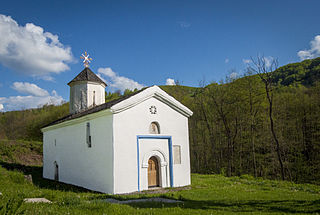
The Church of Saint Nicholas is a church of the Serbian Orthodox Church, located in the village of Brezova, 26 km southwest of Ivanjica. Situated on Mučanj mountain, it was built during the first half of the 17th century at the place of an older church. Folk tradition links the construction of the church with Despot Stefan Lazarević whose fresco portrait is located in the church, although he lived in the 15th century.

Church of Saint Nicholas was a Russian Orthodox Church built in Baku between 1850 and 1857.
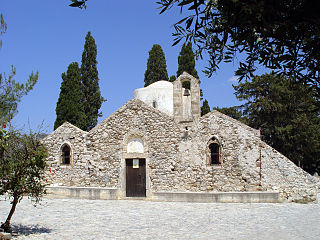
The Church of Panagia Kera is a Cretan Byzantine church, located 1 km from the village of Kritsa, in the Dikte Mountains. It contains the finest-preserved Byzantine-era frescoes in Crete, and for that reason, has become one of the most culturally and historically significant churches on the island.

The Church of Saint Demetrius or the Church of the Holy Trinity was a Serbian Orthodox church in Budapest, Hungary, located in the Tabán area. It was built between 1742 and 1751 in Central European Baroque style by the Serbian community of Buda, and served as the co-cathedral of the Eparchy of Buda. The building was seriously damaged in the siege of Budapest in 1945, and the ruins were demolished in 1949.
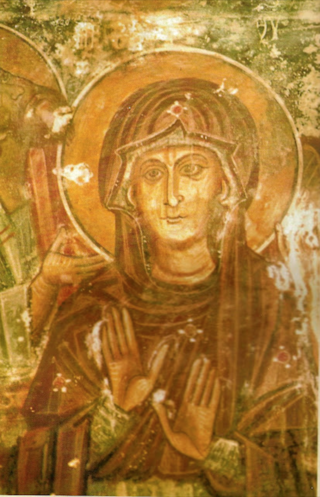
Ioannis Pagomenos was a Greek painter in the Byzantine style active in Venetian-ruled Crete. He created fresco cycles for rural Orthodox churches under commission from ordinary members of the local peasant communities, who acted as collective patrons. While he could be considered a forerunner to the Cretan School, which saw success in producing hybrid-style icons for an international clientele, his work was more traditional in character and only incorporated Western influences in secondary details, as it catered to regional tastes. His style nonetheless shows significant development over the years. His frescos survive in four districts of the Chania prefecture, with the majority in the mountainous province of Selino, which displays the highest density of church painting in Crete. His art influenced Andreas Pavias, Angelos Akotantos, Andreas Ritzos, and Nikolaos Tzafouris. By 1337/8 Pagomenos was working together with his son Nikolaos within the framework of a small family workshop of painters, other examples of which are known from contemporary Crete and the Aegean.

The Cathedral of the Assumption is a Russian Orthodox cathedral located in the city of Makhachkala, the capital of the Russian Republic of Dagestan. It is the seat of the Diocese of Makhachkala.

Feodorovskaya Icon Cathedral — an Orthodox church in Saint Petersburg, Russia. It belongs to the Central Deanery of the St. Petersburg Diocese of the Russian Orthodox Church. The cathedral was built in Commemoration of the Romanov Tercentenary.

The Cathedral of Saint Titus also known as Hagios Titos, is an Orthodox church in the city of Heraklion, Crete, dedicated to Saint Titus. The current church was built in 1869 as the Yeni Cami and in 1925 it was converted to Christian worship. The church was declared a cathedral of the archdiocese of Crete in 2013. The church is an eclectic style square temple with a dome. The exterior of the temple is dominated by vertical elements, while at the top there is a stone-carved apse.

The Church of Saint Nicholas is a Greek Orthodox church located in the Splanzia square in the town of Chania, Crete, Greece. It is dedicated to Saint Nicholas. Originally a Catholic church, it was converted into a mosque during the Ottoman period and then back into a church in the twentieth century. It is the only building in Greece to possess both a bell tower and a minaret.


